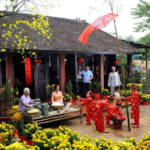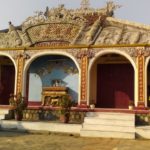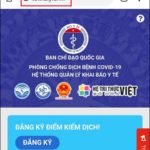The Mid-Autumn Festival is one of the biggest festivals in Vietnam, and it’s a time for both children and adults to come together and celebrate. Falling on the 15th day of the 8th lunar month, it is also known as the Children’s Festival, as kids look forward to receiving star, carp, and military lanterns, as well as paper masks, and mooncakes from their elders.
1 When is Mid-Autumn Festival?
The Mid-Autumn Festival, or Tet Trung Thu in Vietnamese, is celebrated on the 15th day of the 8th lunar month every year. This year, in 2023, it will fall on September 29th on the Gregorian calendar.
For reference: What is it? Learn about the Reunion Festival traditions of the Vietnamese.
 When is Mid-Autumn Festival 2023? How many days until Mid-Autumn Festival 2023?
When is Mid-Autumn Festival 2023? How many days until Mid-Autumn Festival 2023?
2 Origin and Legends of Mid-Autumn Festival
Legend of the Moon-walking Emperor
According to ancient tales, on the bright and clear moonlit night of the 15th day of the 8th lunar month, Emperor Ming Huang of the Tang Dynasty (713-741 AD) went for a stroll in the royal garden to enjoy the cool breeze and admire the full moon. There, he encountered a Taoist immortal who magically transported the emperor to the Moon Palace.
In the Moon Palace, the emperor was mesmerized by the luxurious surroundings and the enchanting dances and songs performed by beautiful fairies. So captivated was he that he forgot the time, and it was only when dawn approached that the immortal reminded him to return to Earth. However, the emperor’s heart remained captivated by the Moon Palace.
Back in the imperial palace, the emperor continued to long for the moonlit night and the wonders he had experienced. Thus, every year on the 15th day of the 8th lunar month, he would order the people to organize lantern processions and feast in celebration of the moon. The emperor and his beloved concubine, Yang Guifei, would drink wine under the moonlight, watching the dancing and singing court ladies, and reminiscing about the magical journey to the Moon Palace.
 The lantern processions and feasts during the full moon of the 8th lunar month became a folk tradition.
The lantern processions and feasts during the full moon of the 8th lunar month became a folk tradition.
Since then, the lantern processions and feasts during the full moon of the 8th lunar month became a folk tradition. Some also believe that this tradition originated from the birthday of Emperor Ming Huang, as the Tang Dynasty court ordered the people to hang lanterns and hold celebrations in honor of the emperor’s birthday.
Both the Chinese and Vietnamese people make and eat mooncakes during this festival, offering them to their ancestors and presenting them as gifts to loved ones and friends. They also organize lantern processions to celebrate the Mid-Autumn Festival.
The Legend of Chang’e
 The Legend of Chang’e
The Legend of Chang’e
Another legend associated with the Mid-Autumn Festival is that of Hou Yi and Chang’e. They were once immortal gods living on the moon, but due to jealousy and envy, Hou Yi was falsely accused and banished to live as a mortal.
One day, the ten sons of the Jade Emperor transformed into ten suns, scorching the earth with their intense heat. Despite the Jade Emperor’s orders for them to stop, they refused, and so he summoned Hou Yi to save the earth. With his exceptional archery skills, Hou Yi shot down nine of the suns, leaving only one to illuminate the world.
As a reward, the Jade Emperor gave Hou Yi an elixir of immortality, instructing him to consume it only after one year had passed. Hou Yi brought the elixir home and hid it in a box, warning his wife, Chang’e, not to open it. However, while Hou Yi was away, Chang’e opened the box and swallowed the elixir, immediately ascending to the moon. Despite his love for his wife, Hou Yi could not bring her back to Earth.
Longing for his wife, Hou Yi built a palace in the sun and named it “Yang,” while Chang’e built a similar palace on the moon, naming it “Yin.” Once a year, on the 15th day of the 8th lunar month, Chang’e and Hou Yi would be reunited in happiness.
The Legend of Cuoi on the Moon
 The delicious-smelling pastries emerged from the oven, and the children devoured them, praising their wonderful taste.
The delicious-smelling pastries emerged from the oven, and the children devoured them, praising their wonderful taste.
In Vietnam, the legend of Chang’e is linked to Cuoi, a legendary joker. It is said that Chang’e, a beautiful fairy who loved children, often descended to Earth to play with them, despite the prohibition of the fairy realm.
One day, the Jade Emperor organized a “Mooncake-making Contest” on the full moon night, promising a grand prize to whoever made the most delicious, beautiful, and unique mooncakes.
Chang’e came down to Earth and met Cuoi, who claimed to be a pastry expert. Cuoi instructed her to mix all the ingredients and bake them, and to their surprise, the resulting mooncakes smelled and tasted amazing.
Chang’e returned to the moon with the mooncakes to participate in the contest and won first place. Her mooncakes were named “Trung Thu cakes,” and she wished that every year on the 15th day of the 8th lunar month, she and Cuoi could descend to Earth to play with the children. Thus, the Jade Emperor named this festival “Tet Trung Thu” – a joyous celebration for children.
3 Significance of the Mid-Autumn Festival
The Mid-Autumn Festival was initially a festival for adults to appreciate the beauty of nature, eat pastries, and sip tea while admiring the full moon in the cool autumn breeze. Over time, it evolved into a children’s festival, as they particularly enjoyed the traditions of lantern processions and feasting. In Vietnamese culture, parents prepare a feast for their children to celebrate the festival, buying or making various lanterns illuminated by candles to hang in their homes and for the children to carry during processions. This festival is an opportunity for children to feel the love and care of their parents.
At the same time, it is a chance for people to express their gratitude to their elders, ancestors, and those who have helped them. People buy mooncakes, tea, and wine to offer to their ancestors and present as gifts to their elders, parents, teachers, friends, relatives, and benefactors. In doing so, familial love, neighborhood bonds, and friendships are strengthened.
 The Mid-Autumn Festival was originally a festival for adults.
The Mid-Autumn Festival was originally a festival for adults.
This beautiful tradition has been preserved to this day and has evolved to fit different eras.
In modern times, with smaller families often living apart and children working far from home, the Mid-Autumn Festival serves as a precious opportunity for families to reunite. Setting aside the hustle and bustle of daily life, they gather to share stories, concerns, and love for one another. Thus, the Mid-Autumn Festival has become a family reunion, a celebration of kinship.
 The Mid-Autumn Festival has become a family reunion, a celebration of kinship.
The Mid-Autumn Festival has become a family reunion, a celebration of kinship.
Family Reunion on Mid-Autumn Festival Eve
According to Vietnamese customs, all family members look forward to gathering and preparing an ancestral offering on this special night.
As the moon rises, bathing the earth in its golden light, families and neighbors come together to sip green tea, eat pastries, admire the moon, and display fruits and sweets for the children to enjoy. They also participate in lantern processions, lion dances, moon gazing, and other festive activities.
Additionally, people buy mooncakes, tea, and wine to offer to their ancestors and present as gifts to their elders, parents, teachers, friends, and benefactors. It is a wonderful opportunity to express gratitude and care for one another.
 Family members look forward to gathering and preparing an ancestral offering.
Family members look forward to gathering and preparing an ancestral offering.
Family members eagerly anticipate coming together to prepare offerings for their ancestors.
Lion Dance During the Mid-Autumn Festival
The Chinese often organize lion dances during the Lunar New Year celebrations, while the Vietnamese reserve this tradition for the Mid-Autumn Festival.
The lion is a symbol of good luck and fortune. In the past, the Vietnamese also organized Trống Quân singing during the Mid-Autumn Festival. This singing was performed to the beat of “thình, thùng, thình” (a type of drumbeat).
Young men and women would sing Trống Quân songs during moonlit nights, especially on the full moon of the 8th lunar month.
 Longing for home and missing his siblings, Cuoi could only sit and weep beneath the tree.
Longing for home and missing his siblings, Cuoi could only sit and weep beneath the tree.
The Mid-Autumn Festival Connects People
Young men and women would sing and respond to each other, using this opportunity to find their life partners. They would compose poems in the form of six-eight or modified six-eight verses to sing during this festival.
The Mid-Autumn Festival was initially a festival for adults to appreciate the beauty of nature, eat pastries, and sip tea while admiring the full moon in the cool autumn breeze. Over time, it has become a children’s festival, with adults also taking part in the celebrations.
Children eagerly look forward to carrying lanterns, singing, and enjoying the feast prepared by their parents and elders. They also relish the opportunity to indulge in sweets and snacks without reprimand.
The Mid-Autumn Festival holds a special significance. It is a time for care, filial piety, gratitude, friendship, reunion, and love.
 Over time, the Mid-Autumn Festival has become a children’s festival, with adults also taking part in the celebrations.
Over time, the Mid-Autumn Festival has become a children’s festival, with adults also taking part in the celebrations.
4 Alternative Names for the Mid-Autumn Festival
As a long-standing traditional festival in Vietnam, the Mid-Autumn Festival has several alternative names, including Reunion Festival, Lantern Festival, Moon-gazing Festival, and Children’s Festival.
For reference: What is it?
5 Customs and Traditions of the Mid-Autumn Festival
Lantern Processions
The Mid-Autumn Festival is synonymous with colorful lanterns illuminating the night under the golden moonlight. In Chinese culture, people hang lanterns in front of their homes to symbolize good luck and peace. Some also make floating lanterns, inscribing their wishes on them before releasing them into rivers, carrying their prayers far and wide.
In Vietnam, lanterns of various shapes and colors are crafted from everyday materials such as paper, fabric, silk, colored plastic, bamboo, and candles. These lanterns carry different meanings for the Vietnamese people.
For reference: Easy-to-make lantern ideas for a memorable Mid-Autumn Festival.
 The Mid-Autumn Festival is synonymous with colorful lanterns.
The Mid-Autumn Festival is synonymous with colorful lanterns.
Moon-gazing
Falling on the 15th day of the 8th lunar month, the Mid-Autumn Festival coincides with the brightest full moon of the month. This presents an ideal opportunity for families to gather and share their thoughts and experiences under the enchanting moonlight.
For the Chinese, walking under the moon on this night symbolizes family reunion. In Vietnam, the Mid-Autumn Festival is considered the most pleasant time of the year, with the moon illuminating the landscape. Families gather to admire the moon, chat, and enjoy the festive atmosphere.
Worshipping the Ancestors on the 15th Day of the Lunar Month
Explore 12 Amazing Destinations for Biking Trips
Unlock Vietnam in a brand new way with an exciting biking tour! Discover the stunning beauty of the country with Dien May XANH’s top 12 must-see destinations. From sweeping plains to clear blue beaches and mountainous vistas – experience all the sights with your own personal cycling tour. Find your ideal route and set out for an adventure today!






































